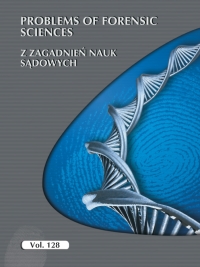A comparison of prospective calculations with experimental alcohol curves
A comparison of prospective calculations with experimental alcohol curves
Author(s): Dominika Jama, Karolina Sekuła, Dariusz ZubaSubject(s): Criminology, Substance abuse and addiction
Published by: Wydawnictwo Uniwersytetu Jagiellońskiego
Keywords: alcohol; Prospective calculations; alcohol curve; absorption; elimination;
Summary/Abstract: In cases requiring determination of the ethanol content of a person involved in a road incident, expert opinions are often based on prospective calculations. Declarations regarding the amount and type of alcoholic drink consumed are used to calculate the concentration of alcohol in the body and to correlate the results obtained with those of sobriety tests. alcohol concentration estimated using a prospective calculation should correspond most accurately with the ethanol content in the body. It is therefore desirable to identify the appropriate model of prospective estimation, which is accomplished here by comparing the most common methods of alcohol calculation used by forensic experts. The study involved five people aged 29–64 (two women and three men) who were given alcohol in an amount leading to a theoretical ethanol concentration of 1‰in their bodies. In this paper, we plotted the alcohol curves and compared the experimental (real) ethanol concentration with the theoretical values calculated by the various methods. The best correlation between the results of prospective calculations and real ethanol concentrations was obtained for the method that assumes an immediate elimination from the beginning of consumption (used routinely by the authors) and for the method that assumes an absorption time of 30 minutes and a 10% alcohol deficit (the difference between the theoretical and actual ethanol concentration).
Journal: Problems of Forensic Sciences
- Issue Year: 2021
- Issue No: 128
- Page Range: 241-258
- Page Count: 18
- Language: English

